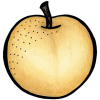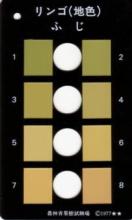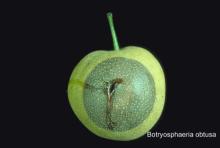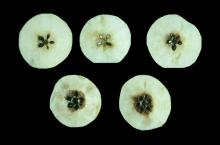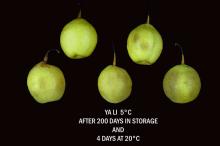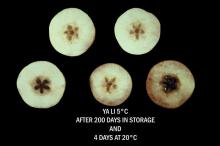Maturity and Quality
- Change in skin color from green to yellowish green (Nijisseiki or 20th Century, Shinseiki, Tsu Li, Ya Li) or to golden brown (Hosui, Kosui, Niitaka, Shinko)
- Delayed harvest (which does not always mean higher soluble solids content) results in increased incidence and severity of physiological disorders and greater susceptibility to physical injury
- Freedom from mechanical injuries ('20th Century' pears are very sensitive to impact and compression bruising; 'Tsu Li' and 'Ya Li' pears increase in susceptibility to bruising after storage; 'Chojuro' pears are firmer and more resistant to mechanical damage)
- Flesh firmness (penetration force using an 8-mm tip) of 7 to 10 lb-force depending on cultivar is optimum for eating; only small changes in firmness occur during storage at 0°C (32°F)
- Juiciness (not mealy) and sweetness (11 to 14% soluble solids depending on cultivar)
- Nutritive value: good source of dietary fiber
Postharvest Handling and Storage
0 ± 1°C (32 ± 2°F)
Freezing point: -1.5°C (29°F); may vary depending on soluble solids content.
| Temperature | 0°C (32°F) | 20°C (68°F) |
|---|---|---|
| ml CO2/kg·hr | 1-4 | 10-15 |
To calculate heat production multiply ml CO2/kg·hr by 440 to get Btu/ton/ day or by 122 to get kcal/metric ton/day.
Exposure of climacteric cultivars to >1 ppm ethylene accelerates loss of green color and slightly increases softening at 20°C (68°F). The effects of ethylene at 0°C (32°F) are minimal.
90-95%
- Some cultivars (such as Nijisseiki, Kosui, and Niitaka) produce very little ethylene (2 production with ripening)
- Other cultivars (such as Tsu Li, Ya Li, Chojuro, Shinsui, Kikusui, and Hosui) have a climateric respiratory pattern (rise in CO2 production with ripening) and produce ethylene, up to 9 to 14 µl/kg·h (Tsu Li and Ya Li) or 1 to 3 µl/kg·hr (other cultivars) at 0°C (32°F)
- Based on limited studies it appears that the magnitude of CA benefits for Asian pears is cultivar-specific and is generally less than that for European pears and apples
- CA may extend storage durations of some Asian cultivars by about 25% relative to storage in air
- Oxygen levels of 1-3% for some cultivars (such as Nijisseiki) or 3-5% for others (such as Ya Li) help retain firmness and delay changes in skin color
- Asian pears are sensitive to CO2 injury (above 2% CO2 for most cultivars) when stored longer than a month
Temperature & Controlled Atmosphere Photos
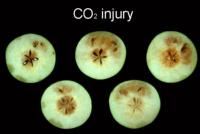 High CO2 Internal Injury High CO2 Internal Injury |
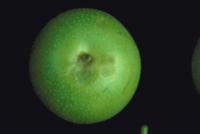 Low O2 External Injury (1) Low O2 External Injury (1) |
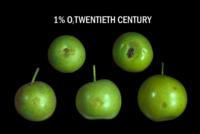 Low O2 External Injury (2) Low O2 External Injury (2) |
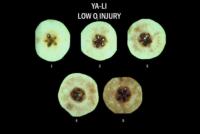 Low O2 Internal Injury (2) Low O2 Internal Injury (2) |
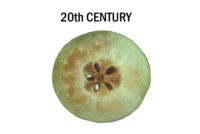 Low O2 Internal Injury (1) Low O2 Internal Injury (1) |
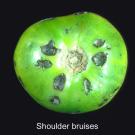
Disorders
Low oxygen injury. (Discolored surface depressions) Resulted from exposing '20th Century' pears to 1% O2 for 4 months at 0°C (32°F) and from exposing 'Ya Li' and 'Tsu Li' pears to 1% O2 for 2 months, 2% O2 for 4 months, or 3% O2 for 6 months at 0°C (32°F).
High carbon dioxide injury. (Core or medial flesh browning; cavities may develop in severe cases as a result of desiccation of dead tissue) 'Ya Li' pears exhibited CO2 injury after exposure to 5% CO2 for 6 weeks at 0°C (32°F).
Flesh spot decay. (FSD) Symptoms (brown spots and/or cavities in the flesh) appear along and around the vascular bundles when severe but are not visible externally. FSD affects mainly Nijisseiki, Shinseiki, and Hosui Japanese pear cultivars and is usually more pronounced toward the stem end of the fruit, but can occur all the way down to the calyx. FSD incidence and severity can be reduced by avoiding harvesting over-mature fruits.
Watercore. Symptoms (glassy diffuse water soaked areas in the flesh; affected areas may taste sweet and may turn slightly brown) occur on some cultivars (such as Nijisseiki, Shinseiki, and Hosui) grown under conditions favoring vigorous tree growth. Avoid harvesting over-mature fruits to reduce watercore incidence and severity.
Internal browning. Symptoms (brown discoloration in the core, carpels, and flesh areas) appear mainly in Chinese pear cultivars (such as Tsu Li, Ya Li, Seuri, and Dan Be). This disorder can be avoided if the fruits are picked when still green with a few fruits at the top of the tree showing some light yellowish green color (after about 180 days after full bloom).
[For more information, see our publication "Fruit Ripening and Ethylene Management", available for purchase using our Publication order form.]



